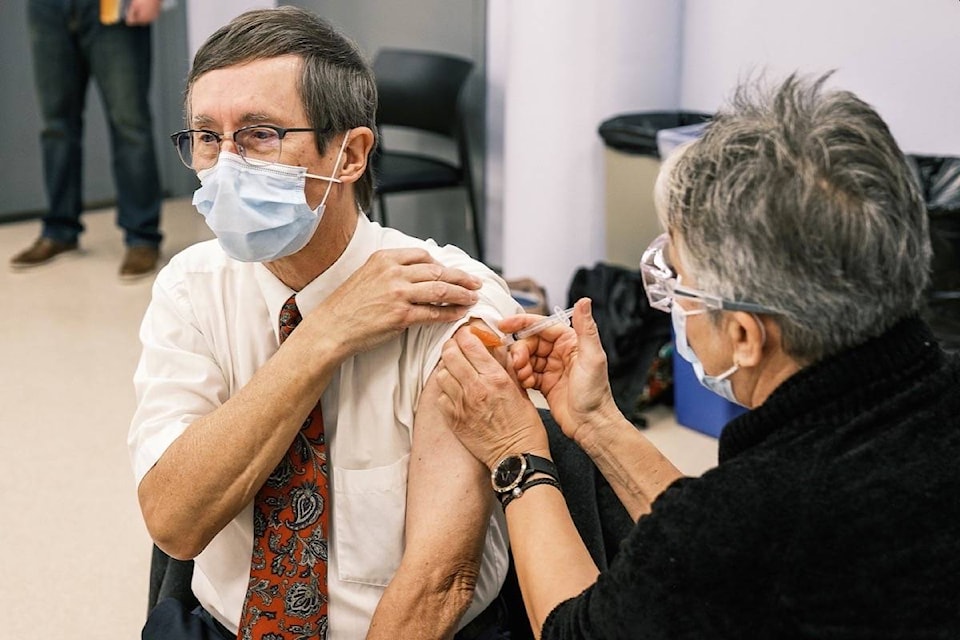Dr. Bonnie Henry is calling it a precipice, a plateau from which the novel coronavirus could spring upwards, or decline.
New cases in B.C. have hovered around 500 per day, but on Vancouver Island, numbers have anything but plateaued.
While B.C. is showing a gradual decline in new cases, Island Health is smashing through new highs weekly. The Island took 10 months to reach 1,000 cumulative cases. Three weeks later, that total has already reached 1,458.
What’s behind the exponential increase? Vancouver Island’s Chief Medical Health Officer Dr. Richard Stanwick isn’t sure.
But whatever the cause, the Island is seeing double digit case counts every day in January. The region has registered 25 or more new cases 11 times. Ten of those totals came in the past three weeks.
Contact tracing teams have gone all out — as of Jan. 26, the region had 753 people isolating after being identified as close contacts, and 217 people confirmed as positive. Total cases are still manageable, hospitals are not at capacity.
In fact, Vancouver Island has been able to offer support to Northern B.C., an area that is bursting at capacity for beds.
Most of the current Island cases are within the Central Island region, between the Nanaimo hospital outbreak, some school exposures, and Cowichan Tribes which has had more than 150 cases. The First Nation’s membership is sheltering in place until at least Feb. 5.
Indigenous people are four times more likely to experience the worst effects of COVID-19, Stanwick said.
“This is open to speculation as to why, whether they are under-housed, or a is there a propensity to it? The simple fact is unfortunately they are more vulnerable to the effects,” Stanwick said.
It’s one of the reasons First Nations communities are included in priority vaccinations along with long-term care and assisted living residents and workers.
RELATED: Cowichan Tribes confirms first death from COVID-19
RELATED: COVID-19 outbreak declared at Nanaimo hospital
“The good news is that we have finished immunizing all long-term care clients who have wished to be immunized as of [Jan. 24], and are working hard to complete all of our assisted living by mid-week,” Stanwick said.
But we’re far from out of the woods, even with positive first steps.
“It’s only the first dose they’ve gotten, and this is where I cross my fingers and my toes. It takes 14 days to get a good immune response mounted by the body. So we’re still vulnerable for two more weeks. There is a possibility we could still see outbreaks in our long-term care and assisted living facilities.”
The First Nations Health Authority has set a goal of delivering vaccinations to all First Nations on the Island by the end of March. That process is well underway.
What really worries Stanwick is the rising number of people who have no clue where they contracted the virus. It makes contact tracing nearly impossible, and makes it a lot harder to control the spread.
Take the U.K. variant for example; one Central Island resident caught it while travelling. They passed it to two others, but all three people followed quarantine rules and the strain died there.
The South African variant — which has not yet been found on the Island — is of unknown origin at this time.
“It’s when it surprises us that’s where we worry the most,” Stanwick said.
Vancouver Island’s positivity rate is another concern. Dr. Henry regularly says the goal is to keep it at 1 per cent or below, but the Island is almost at 4 per cent right now.
“We’re still looking at a few months out for wide vaccinations. We are so close, I’d hate to see us backslide into the same situation as the U.K., going into full lock down,” he said.
“The orders [Dr. Henry] puts in place have worked. They’ve gotten us where we are, we’ve just got to hang in a little longer.”
In the meantime, Stanwick said Vancouver Island Health Authority is assigning environmental health officers to identify places where standards are not being met. It’s not a hunt to issue fines, he said, but an effort to help people understand what Work Safe requirements are. However, they are issuing fines to people unwilling to comply.
For more news from Vancouver Island and beyond delivered daily into your inbox, please click here.
Do you have something to add to this story or something else we should report on? Email: zoe.ducklow@blackpress.ca
